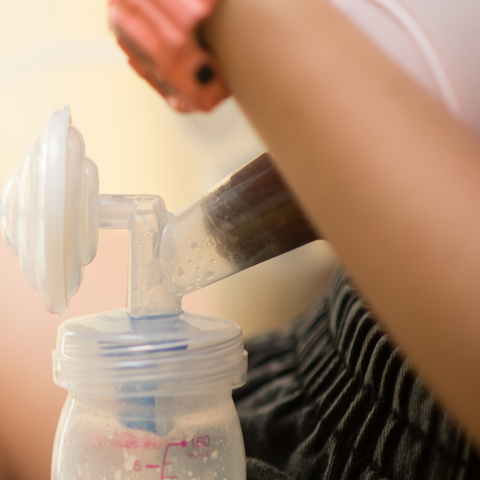Nipple Pain While Pumping? Pumping doesn't have to suck.
I'll be honest, if you're here I'm a little worried about your nipples. Or maybe you're just looking to ask "do breast pumps hurt?" Either way- I'm glad you're here. The short answer is no, you shouldn't have nipple pain while pumping. Unfortunately, there is a lot of room for error with a breast pump, so if you have continued pain after making the adjustments discussed below, I would encourage you to book an appointment with a Feed Well Co. lactation consultant or another IBCLC who is familiar with different pumps and how to properly size flanges to end your nipple pain while pumping. I promise there are options out there to make pumping more comfortable.
Flange Sizing
Believe it or not, almost every pumping parent I size is using a flange that is far too large. If the flange is too big, it can lead to the areola and breast tissue being pulled into the tunnel and can be a major cause of nipple pain while pumping. There's a steep learning curve to sizing flanges and many people use flanges that are causing nipple pain while pumping. Nipple pain while pumping aside, flanges that are not fit correctly can also cause clogged ducts, mastitis, and low supply. If you are still using the size 24mm or 28mm flange that came with your pump, or if you are unsure of how to get a great fit make sure you schedule a quick virtual flange sizing consult with one of our lactation consultants. It's the best $25 you'll spend on pumping + 10% off any pump parts you buy in The Shop. End your nipple pain while pumping now!
Here are 4 examples of people who would benefit from a flange sizing.


"OMG! Changing my flange size made all the difference! No more nipple pain while pumping and pump more milk!"
Do breast pumps hurt if you turn them up too high?
Abs.o.lutely. But, I am guilty of this one, too. All it did was give me nipple pain while pumping. Stronger suction = more milk, right? Well, no. Not exactly. A good rule of thumb is to slowly turn it up till it's slightly uncomfortable, then turn it back down one notch. If you're using a Spectra, most consultants feel that with good flange sizing and proper pump usages, using suction 4-7(~ish) is high enough to effectively extract the milk. If the flanges are too small or big, you may find yourself compensating for the poor fit by increasing the suction to empty your breasts or chest. In addition to nipple pain while pumping, turning up the pump too high can cause internal breast damage, swelling, or broken capillaries. Take it from a pro, you don't get a trophy for turning your pump as high as you can.
Existing Nipple Trauma or Damage
This one seems like a no-brainer, but many people have abrasions, cracks, or blebs causing their nipple pain while pumping and don't realize it. If pumping has previously been very comfortable, you'll want to do a physical examination of your nipple. If you find an unwelcomed abrasion or bleb you'll want to take care of it quickly to improve pumping comfort and hopefully prevent any bacteria from causing an infection. If you are pumping for supplementation or exclusively, then it is likely you will need to continue removing milk from your breasts as scheduled. If it is too painful, try hand expressing to remove the milk and prevent further damage or clogged ducts/mastitis.
"I've been suddenly having nipple pain while pumping- I looked down and I have a big belb! What do I do?!"
The Big Let Down
While some parents cannot and will never feel a letdown, for some people the letdown can be very painful. This pain typically occurs in the first few minutes of pumping, and a few times throughout the course of your session, but can certainly be a cause of nipple pain while pumping. It is often accompanied by shooting streams of milk, or an increase in drops coming out. This pain is short-lived and can usually be felt on both sides. While there aren't a ton of comfort measures for let down pain, trying to breathe through the pain or set your mind on something else can be helpful.
Other Considerations
We've discussed the most common causes of nipple pain while pumping, but here are a few other points to consider to improve comfort:
- Use a pumping lubricant in the tunnel to reduce friction
- Use care to ensure your nipples are in the center of the tunnel
- Alternatively shaped flanges like Pumpin' Pals or Lacteck
- Pump cushions like the Beaugens
If you have any questions or want to chat about nipple pain while pumping, don't hesitate to reach out- feel free to email us your question at info@feedwellco.com. We do want you to have nipple pain while pumping any longer!

